How to Grow Squash for Beginners
Get our best tips on How to Grow Squash for Beginners so you can add this amazing plant to your backyard garden. How to plant, tend, grow, and harvest zucchini so you can fill your freezer and more.
Get another helpful guide that will grow your Gardening 101, library with all the resources you need for a huge harvest.
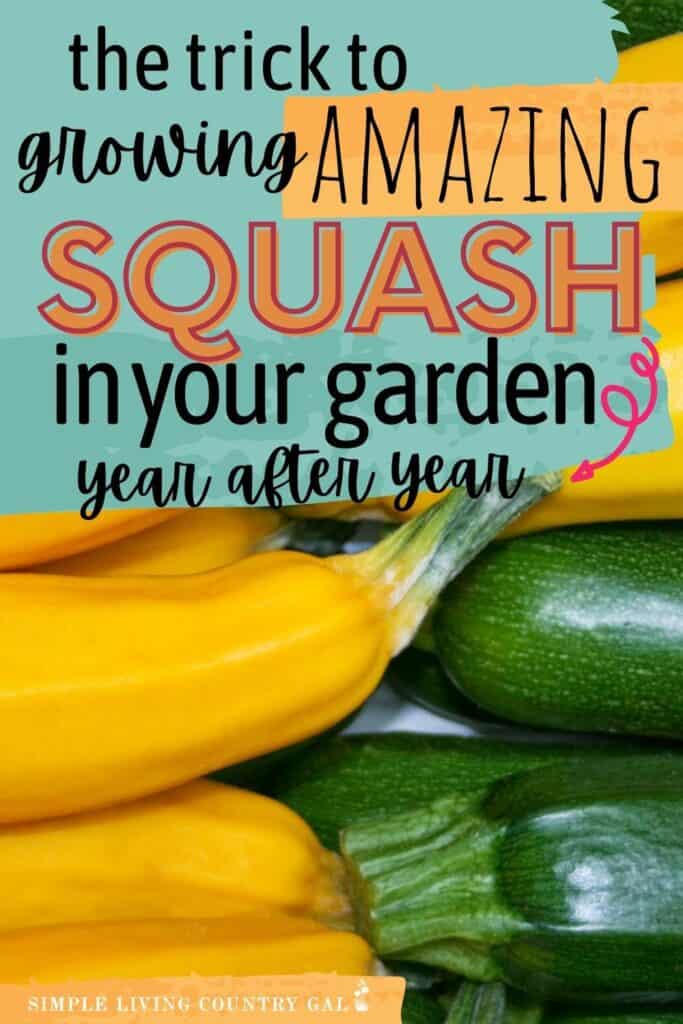
Squash might just be today’s most versatile food that is found in the backyard garden. There are some really fun varieties you can grow with the most popular being zucchini.
Squash is becoming very popular and you can get quite creative with your meals.
- Spaghetti squash is a healthy replacement for pasta.
- Zucchini can be stuffed or roasted turning it into the main course.
- Yellow squash can be sliced and marinated along with other veggies that you can grill and created a delicious side-dish medley.
- Acorn Squash is delicious all on its own with a little butter and brown sugar.

Growing squash can save you big money on your grocery bill, give you plenty of amazing and fun meal ideas, and even get your kids involved in healthy eating when they chip in and help to grow their own food.
What to Know When Growing Squash
There are two main types of squash to consider, summer squash and winter squash.
Summer Squash
Summer squash grows best in the summer and needs to be planted after the last frost of the season. Maturity takes about 50-65 days giving you an early harvest.
Summer squashes have a more tender, thin skin and grow in abundance. Zucchini is probably the most common summer squash along with yellow squash.
Winter Squash
Winter squash, on the other hand, should be planted in mid-summer. It can take as long as 100 days to grow and mature so you’ll be able to harvest just before the cold winter weather sets in.
When harvested properly, squash can last for months in a cool, dark storage area. You can also can or freeze to extend your supply even longer.
Winter squashes have thicker, more protective skin that allows them to last longer in storage. Some common varieties include Butternut, Acorn, Spaghetti, Hubbard, and Pumpkin.
Flowers
Squash produces both male and female flowers. In the early growth period, the male flowers will be noticeable first, followed by the female flowers (they have tiny squash below the blossoms).
During the pollination process, male flowers often fall off and die. This is completely normal so don’t be alarmed if you see this happen.
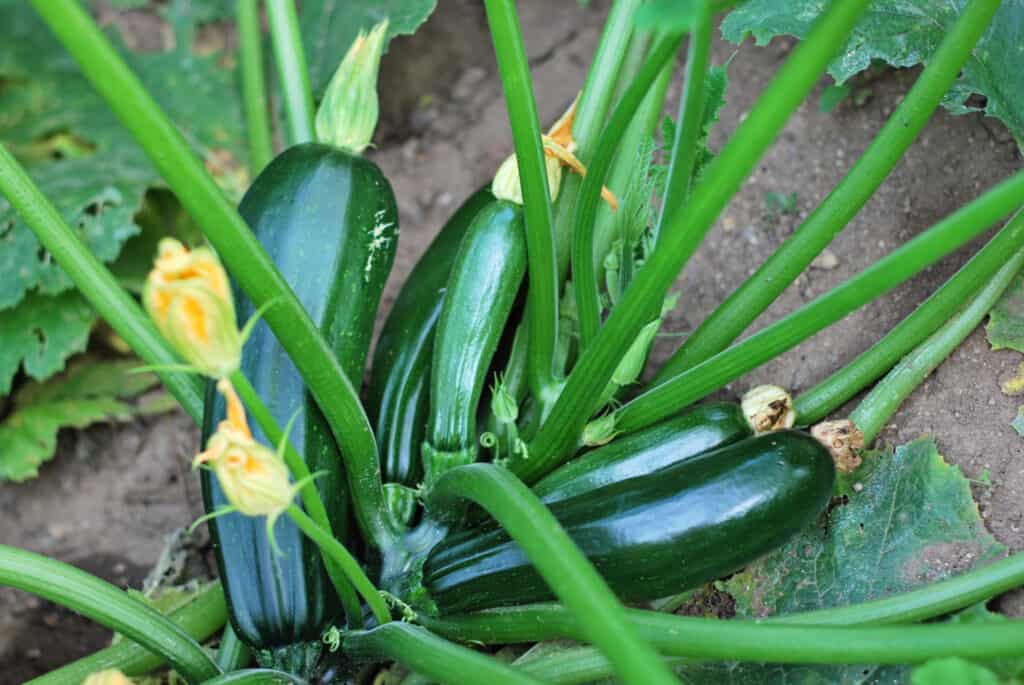
Can you grow squash in containers?
Squash does really well in containers and grow bags allowing you to grow plants in small areas such as a back porch or a flower bed as we do.
Be sure you have enough room for the roots to grow strong and take hold. This will ensure you have a sturdy plant that will hold up all growing season.
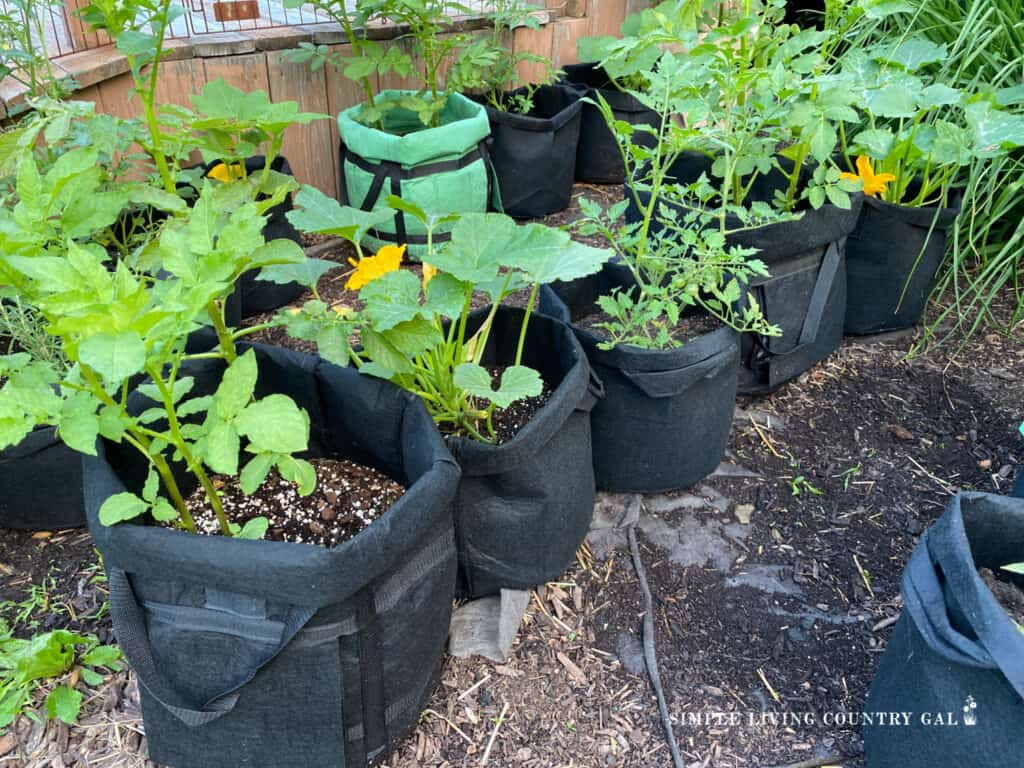
Grow bags are a great way to grow not only squash but your entire garden. Not only do they allow for drainage, but there is plenty of room for roots to establish, and you can move them with ease.
When growing in containers, you eliminate the need for weeding, which is a bonus!
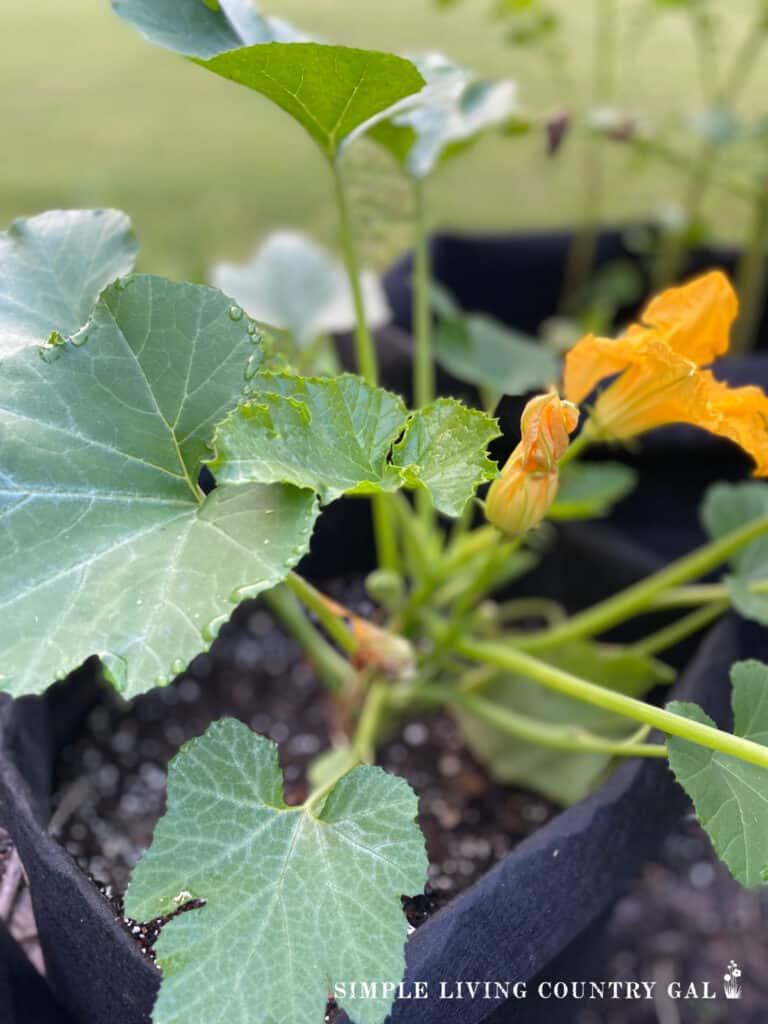
How to grow squash
There are a few things to know for growing squash. Let’s look at each area in more detail.
Soil and drainage
Squash requires soil with good drainage. You’ll want to prepare the soil by mixing in a 3-inch layer of compost or an aged compost-enriched soil before planting. This not only helps to prepare the soil for planting but gives the roots something to wrap around as they grow.
Space
Squash plants require plenty of space to grow. For bush varieties, plant your rows 4-6 feet apart with plants spaced 15-20 inches apart. Vining varieties need more space between rows, 6-12 feet apart with plants 12-15 inches apart.
If you’re planting in mounds, a very common technique for gardeners, space your mounds 6-8 feet apart.
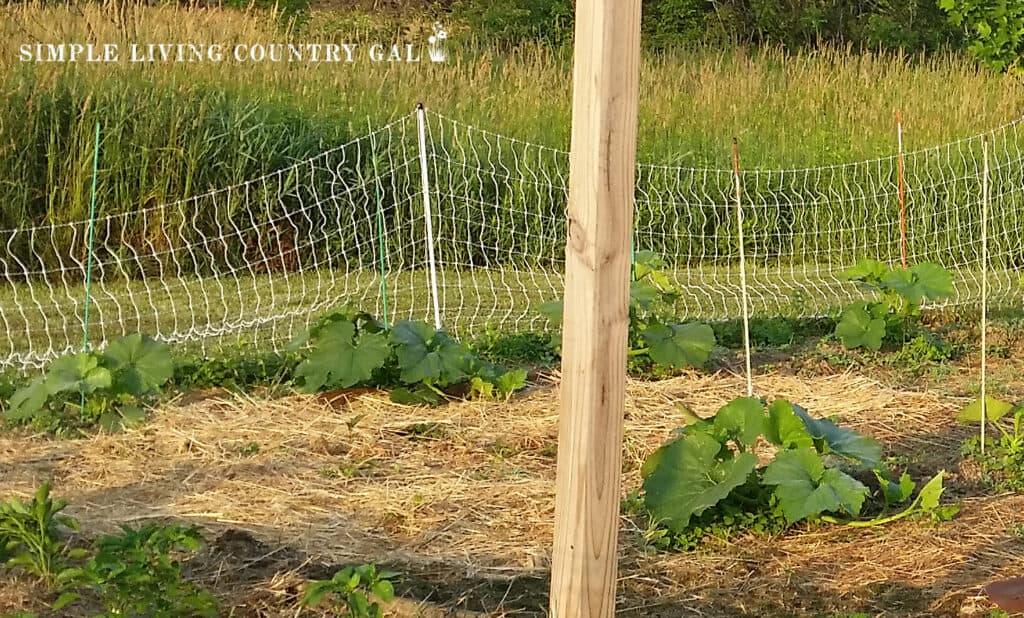
Fertilizer
A continuous-release fertilizer will help plants grow big and plentiful. You can add it to the soil before planting and again as the plant starts to grow.
Squash leaves grow broad and dense, helping to reduce weeds naturally and keep the soil cool, so a light layer of mulch is all you need to help protect your plants. Get our best tips on How to Mulch Plants in Your Garden to grow a healthy, vibrant garden.
Seeds or Plants
Either seeds or plants work just fine, but you can get a jump on the season by starting your plants indoors 3-4 weeks before the last frost.
After the last frost, check the soil temperature. It should reach 70° before planting. If planting seedlings in sunny weather, I suggest you cover them with an upside-down flower pot or another shade source for a few days to prevent wilting.
Seeds can be grown in peat pots and then replanted in your garden when the temperature is right, just be sure not to disrupt the root system when replanting. 3-4 seeds per pot is best to ensure proper growth then you can thin to 2 plants per pot as they start to bloom.
If you’re planting seeds, you can sow them a little closer together, about an inch apart, and thin them out as they grow, getting rid of any unsuccessful plants as you do.
Squash is usually planted in mounds, about 1 inch deep, start out by planting 4-5 seeds per mound in a small circle. As the seeds sprout you will want to thin them out to 2-3 plants per mound. The reason for this is to ensure there is enough room on the mound for the full-sized plants which can get pretty big.
If you are short on space, you can use grow bags and tuck them into open areas around your home or in flower beds.
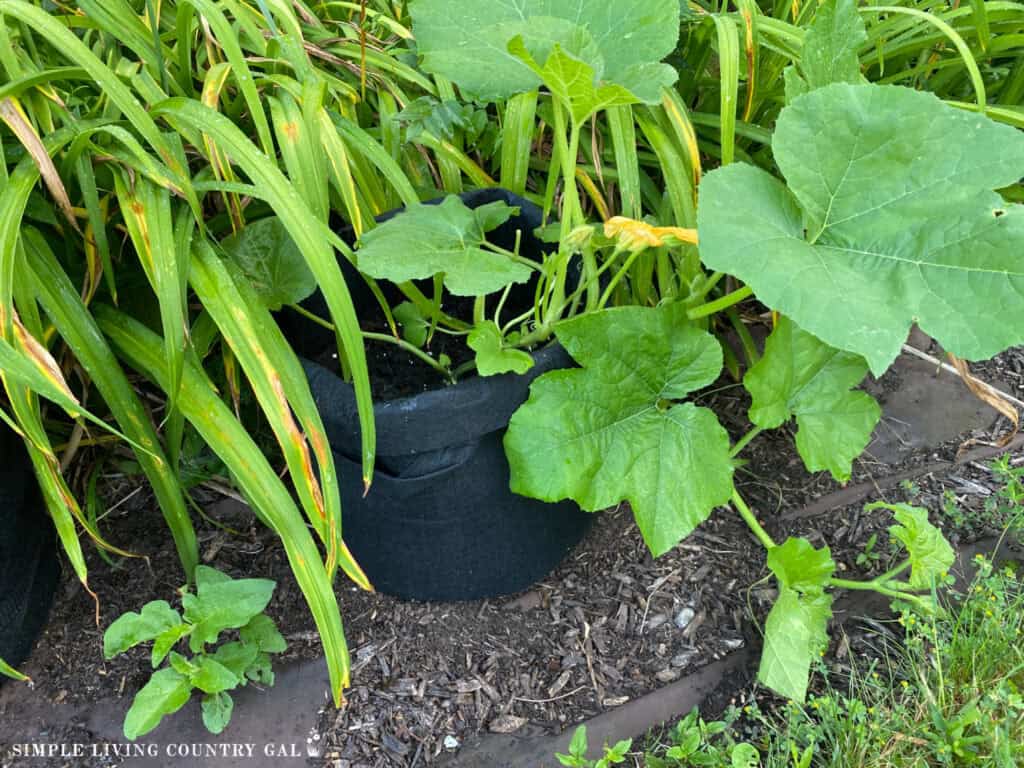
Temperature
Summer and winter squash grow best once the air temperature is an average of 65 degrees or warmer on a daily basis. Late spring is the perfect planting time for summer squash, which means an April planting will give you squash by late June or early July.
Winter squash can be planted mid-summer and will sustain the cooler fall temperatures with their harder skin.
Watering
Squash likes plenty of water, about 1 to 1.5 inches per week, and watered regularly, daily if possible. Your goal is to try to be as consistent as you can with the moisture level of the soil that your squash is planted in.
Try to avoid getting the leaves wet as you water. For this reason, it is best to water low to the ground near the roots. When water splashes up onto the plant and leaves, you run the risk of diseases. Water low to the ground for healthier plants.
How much to plant
Squash plants are high-producing. That means just 1-2 plants per person is all you will need to feed your family for a season.
I remember my first year planting squash. I did 10 mounds of plants, and the shock of that harvest was borderline frightening.
Imagine one day you have a few zucchini showing up, and just a few days later, you have 50. And they kept coming and coming and coming. That was a big lesson learned that first year. One or two plants per person are usually all you need to have enough zucchini to eat and fill a freezer for the year ahead.
Planting Squash – Basic Tips
- Plant summer squash in late spring after the last fall, winter squash in mid-summer
- Space rows 3-6 feet apart with seeds or seedlings spaced about 12 inches apart in row to allow plenty of room for growth
- Planting in mounds will help the squash flourish
- Mounds can be prepared at approximately 2 feet in diameter for spacing and compost can be added to the mound
- Thin out areas that have too many plants to allow for plenty of nutrients and space for the plants you keep
- Summer squash will grow in about 50-65 days, just in time for summer, winter squash will take about 80-100 days to reach full maturity
- When it comes to planting, fertilizing, watering, and sunlight, summer and winter squash both have the same requirements. The only difference it the amount of time it takes them to grow.
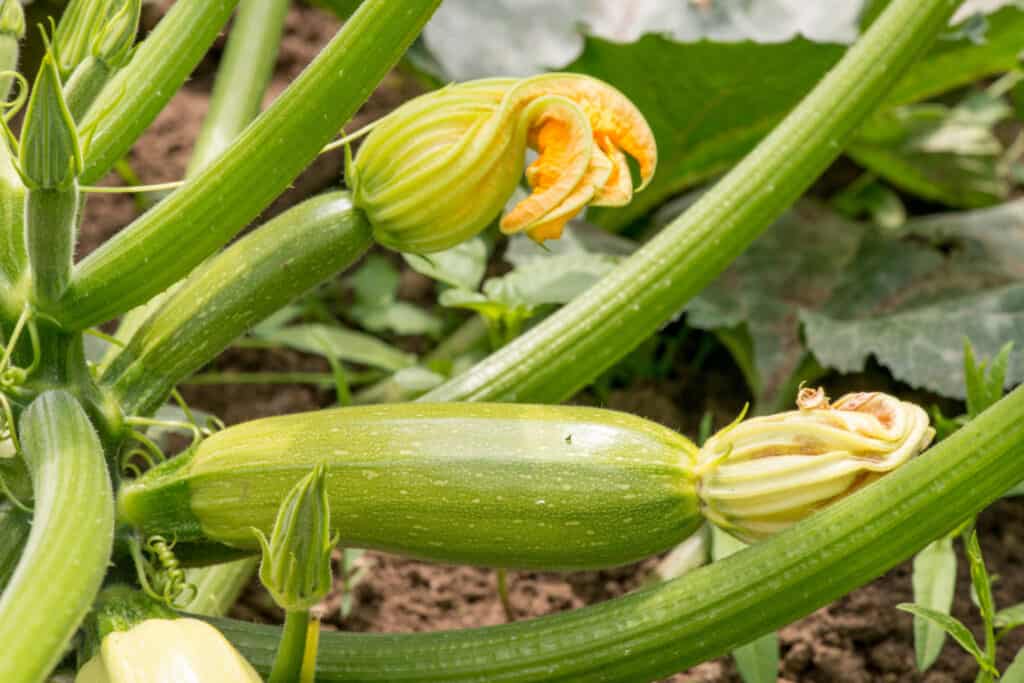
When to Harvest Squash
Baby summer squash can be harvested once they’re large enough to eat or you can wait until they reach their full size of 6-8 inches long before harvesting.
To harvest, use a sharp knife to cut the squash at the neck. You will want to check on things daily and harvest as you go. This will ensure your squash doesn’t over ripen which will reduce the nutrients going to a still-growing plant. Remember, your plants will continue to produce so you want to be constantly picking to keep the plant healthy for the full season.
If, however, you miss a picking, simply remove any overripe squash as soon as possible.
Winter squash will be ready to harvest when the rinds are tough enough to resist being punctured with your fingernail. Cut them with a sharp knife, leaving a short stub of the vine attached to the squash. Winter squash can take a little longer to ripen, so be patient. When it’s fully ripened and harvested at the right time, it will keep in storage for months.
To store it, wipe each squash down with a damp cloth and store it in a basement or cool, dark place until you’re ready to cook.
Things to Watch for When Growing Squash
Pests and diseases are very important to watch out for when growing squash. Once they get into the soil, they can wreak havoc on your crop for years to come.
My best advice to you is to be super vigilant. Each time you go out to water give your plants a good inspection looking for any spots, pests, eggs, or a lackluster look. This one habit will ensure a healthier garden overall.
There are several pests to keep a watch out for:
Squash Vine Borers – These are very common in the mid to eastern US and do quite a bit of damage if they go unnoticed. Borers tunnel through the stems, depriving the fruit and leaves of moisture.
If your plants have wilting leaves and holes at the base of your plant that leave a green, sawdust-type matter, you may have vine borers. They can be hard to control, but there are some prevention methods.
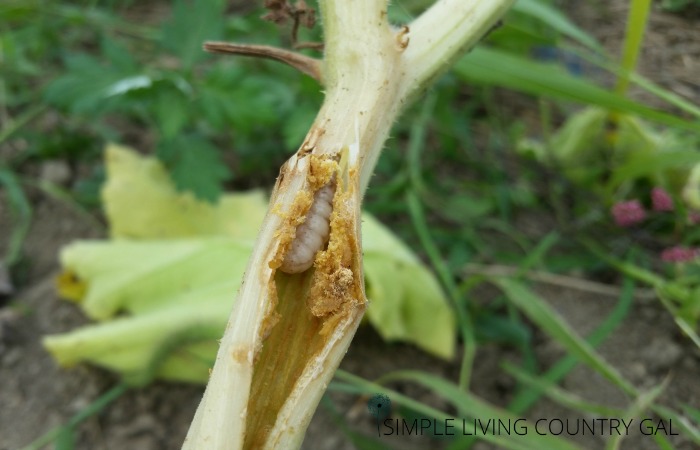
Prevent vine borers by planting varieties of squash with tougher skin, like butternut squash; they are less susceptible to pests. Rotate your squash crops every year but don’t plant them where you previously grew cucumbers or melons; the pests may already be in the soil.
You can also cover the bases of your young plants with aluminum foil to help prevent adult borers from laying eggs. And if you find infected plants, remove and destroy them right away to keep them from spreading and infecting your crop the following year.
Aphids—Aphids are a common garden pest that like to make their home in almost any kind of fruit or vegetable. They especially like leafy greens. Aphids travel in colonies, which makes them easy to spot. Look for discoloration on your plant stems, such as green, purple, and black, as these are common hues of aphids.
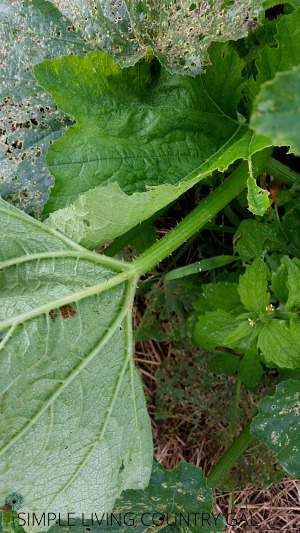
Fortunately, nature will usually help take care of them. In most cases, they only manage to damage a few plants before other insects find them and feast on them, including ladybugs and wasps.
If the infestation gets out of hand though, spray the affected plant stems with a stream of water. This is usually enough to wash them out.
Squash Bugs – These bugs attack the leaves of your plant, causing them to turn black, wither, and break off. You’ll first notice you have these little invaders if you find brown marks on the leaves of your plants. Examine the underside of the leaves regularly to spot them early. If you find clusters of oval-shaped brown eggs, simply remove them.
If they’re already affecting your crop, you can trap them by placing a piece of cardboard or large cabbage leaves on the ground near your plants. The bugs will hide there during the day so you can easily collect them and destroy them.
Growing plants under floating row covers will also help to reduce pests. Just be sure to remove the covers to let in pollinating insects when the plants start to bloom.
A few diseases to be on the lookout for when growing squash include:
Blossom End Rot – The plants will shrivel and turn brown from a lack of calcium. This occurs when they can’t get enough from the soil. Be sure to do a pH test before planting. A pH below 5.5 will cause the plants to have trouble absorbing minerals from the soil.
Powdery Mildew – This appears in powdery spots on the upper and lower surfaces of the leaves. This can weaken the plants and cause premature ripening. Give your plants adequate room to grow to increase airflow around them.
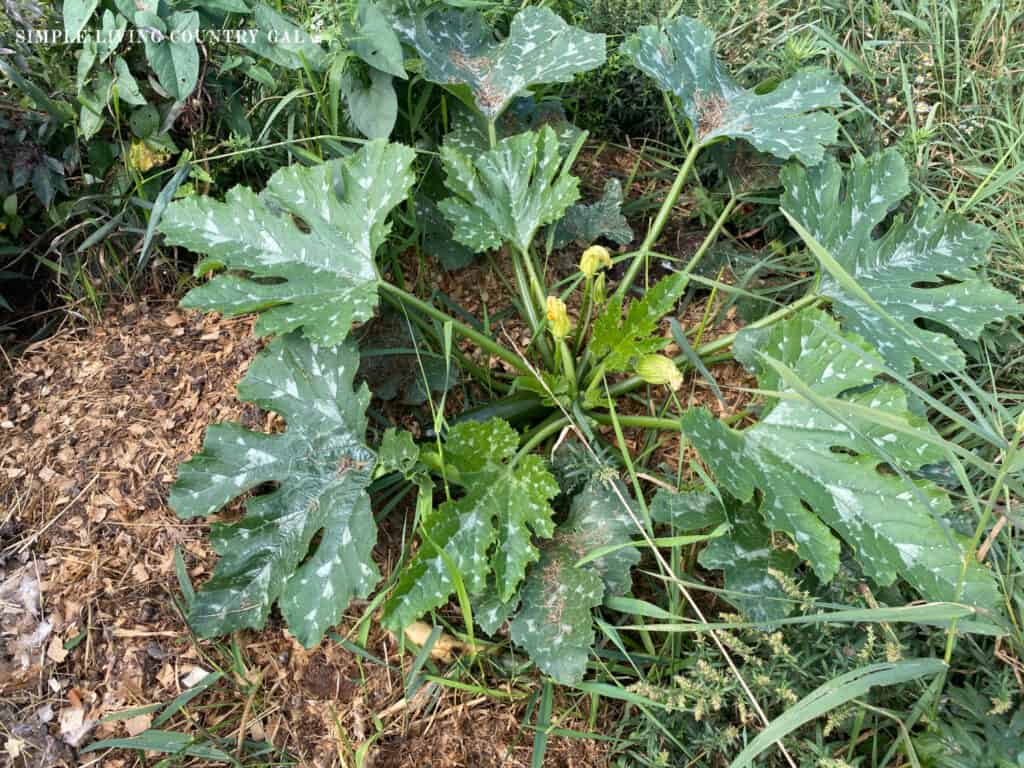
When it comes to growing squash for beginners, you don’t need a lot of experience, just a willingness to tend your garden. Choosing a good site for planting with plenty of nutrient-rich soil and sunlight is key.
Then, caring for your plants and watching for pests and diseases to stop them before they take over will help you produce a healthy harvest.
